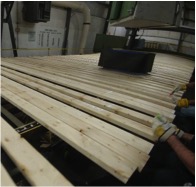Blog #1 – A Little Background Information
June 19, 2018 10:21 am Leave your thoughts
I have been working with West Fraser, Quesnel for the past month and a half. Last summer I was working in their Edson, AB division. My specialization in both internships was in the planer mill.
The planer is the last stage of manufacturing in the modern sawmill. After being cut and dried, the planer is responsible for giving each piece a smooth finish, trimming off the ugly bits, and assigning a grade to the piece. Anyone working in manufacturing will tell you that mistakes are the costliest at the end of the manufacturing process. Say a forklift accidentally stabs a package of lumber. Each piece of lumber that was damaged in this slip up will have gone through a minimum of 14 steps not including multiple steps of transportation, of which none are free. The planer being near the end of the process makes it imperative to be careful and maximize value.
Manufacturing steps performed up to and including the planer:
- Felling
- Bucking
- Debarking
- Canting
- Edging
- Trimming
- Sorting
- Stacking
- Drying
- Planing
- Grading
- Sorting
- Stacking
- Wrapping
My job at the planer is usually centered around step 11, that is grading. For those of you who don’t know what grading is, think of it as a rapid standardized appraisement of lumber. Grading is tightly regulated by a provincial and national regulatory board, they set standards for how many pieces can be below the specified grade in a pack of lumber. This is essential to the treatment of lumber as a commodity, as a pack of lumber being sold by any North American company will be guaranteed to meet a minimum standard in quality.
Historically, lumber grading has been done by hand. Certified human graders had to stand on a production line, flipping over each board and marking it with a grade stamp. In the modern sawmill, this scene has changed significantly with the invention of automatic graders. Automatic graders use a combination of lasers, light, x-rays, stress testers, and moisture meters to analyze over 40 defects every 1/16th of an inch at the speed of over 2 boards a second. Human lumber graders act as a second pair of eyes and help see defects that the machine is not perfect at detecting.
What I do in the grading process is optimize the automatic grader. After grading there are many ways for a defect in a certain piece to worsen; this includes forklift damage, deterioration, and exposure to the elements. The customer doesn’t care that the lumber was perfect when it left the grading table; they care what it looks like on delivery. I determine safety factors to prevent these issues from downgrading the piece after it has been graded. If we are too strict on these safety factors, we risk throwing higher value pieces into lower value bundles; too lenient and we risk customer complaints and compliance issues.
I find it fascinating to work on these machines, seeing a perfectly optimized process is one of the most satisfying feelings. In subsequent blogs I will be featuring the people I work with and the technology used that interns like me will one day be responsible for.

